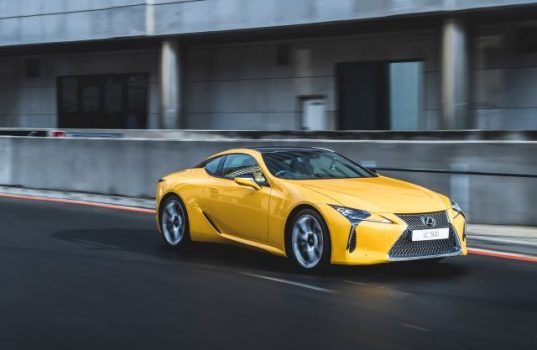All new LC 500 Coupe marks new chapter for the Lexus brand
- Flagship model joins elite class of international grand touring coupes
- New vehicle architecture delivers unfettered driving pleasure
- Winner of multiple Eyes on Design awards
- LC 500 features 351kW high-performance V8 and 10-speed automatic transmission
- New multimedia and safety technologies
The emotional designs and high-performance models issued by Lexus in the last few years prefaced a new chapter for the brand, one that begins now with the arrival of the 2018 LC flagship performance coupe. A concept car come to life, the Lexus LC combines stunning design, scintillating performance, long-distance comfort and premium craftsmanship to join an elite group of international grand touring coupes.
“It is a huge feat for Lexus to have succeeded in turning its amazing LF-LC concept into an uncompromised production car. This would not have been possible without cooperation between the design and engineering teams who worked in tandem throughout the development process. Not only has Lexus delivered a design with high visual impact, it has also developed ground-breaking engineering and technology for the LC 500. This isn’t simply a car that looks good – the LC 500 has been engineered in every dimension to deliver a very special driving experience,” says Calvyn Hamman, Sales and Marketing Senior Vice President of Lexus South Africa.
The Lexus LC makes the strongest statement yet about the brand’s future direction. Previewed by the LF-LC concept in 2012, the Lexus LC debuted as a production model at the 2016 North American International Auto Show in Detroit. While available in both petrol and hybrid in other global markets, only the V8-powered petrol derivative is confirmed for South Africa.
Toyota Motor Corporation president, Akio Toyoda, who is also Chief Branding Officer and master driver for Lexus, inspired the development of the LC. Focused on offering more emotional and exciting vehicles for global markets, he called for a flagship production coupe echoing the spirit of the hand-built Lexus LFA supercar and delivering the visual impact of the Lexus LF-LC concept.
“Our organization has been working to evolve with the changing consumer tastes in luxury,” says Tokuo Fukuichi, president of Lexus International. “The LC’s design, performance, and technology are evidence of this evolution. For Lexus, this flagship coupe also represents a fresh approach to vehicle development. The new LC embodies a shift in forward-thinking culture, and is a glimpse into the products and experiences you can expect from Lexus in the coming years.”
The Motomachi Factory – Home of the LFA and the LC
The LC is built at Lexus’ Motomachi plant, famously home to the production of the hand-crafted LFA supercar. The factory’s layout and facilities have been tailored to the production of the LC, to ensure the highest quality levels.
Many of the Takumi and skilled workers who built the LFA transferred to the LC project, bringing with them a wealth of knowledge and experience, particularly in areas such as the handling of carbon fiber components and hand-finishing.
The new production line at Motomachi has a pure white finish from floor to ceiling to create an environment that helps the team members focus on their work. Each person will spend as much as 20 minutes working on every car, combining hand and eye skills with the use of tablet devices to check and re-check the quality of each process. Skills – both mental and technical – are constantly developed to support a “no compromise” mindset when it comes to achieving Lexus’ rigorous quality standards.
Final checks are carried out in a glass-walled inspection booth with LED lighting – even set into the floor – to ensure the precision finish of all surfaces and bodywork panels, the evenness of color, the quality of the interior and the operation of functioning parts. The substantial thickness of the glass walls also allows the smallest abnormalities in sound to be detected in dynamic checks that monitor noise and vibration.
Provocative, Elegant and Purely Lexus
Debuting at the 2012 North American International Auto Show in Detroit, the Lexus LF-LC was a true concept, not a thinly disguised pre-production prototype. The LF-LC won the EyesOn Design Award for Concept Car and stirred many to question whether Lexus would build it. Earlier this year, Car Design of the Year Awards in Geneva recognized the LC 500 as 2016 Production Car Design of the Year.
Turning the LF-LC concept into a production model while remaining faithful to its visual excitement required nothing less than a new development process combining design and engineering disciplines as never before at Lexus. The process yielded an entirely new platform for the LC, called GA–L (Global Architecture – Luxury), which also forms the foundation for the all-new 2018 LS flagship sedan and will underpin future front engine/rear-wheel drive Lexus models. The platform was designed with a lower center of gravity to aid agility and driving pleasure as well as to enable more alluring vehicle designs.
The production LC preserves the concept’s adventurous appearance, and the design itself helped achieve performance targets, especially with regard to the low center of gravity, aerodynamics and high-speed stability.
New Global Architecture – Luxury platform
The desire was to preserve the LF-LC’s defining low roof and hood lines while ensuring the packaging allowed the LC to match the concept in accommodating a sports suspension and 21” forged alloy wheels. At the same time, all powertrain, chassis, and safety components had to be housed and comfortable headroom had to be provided in the cabin. The teams had the benefit of working on a completely new GA-L (Global Architecture – Luxury) platform, designed for new generations of front engine/rear-wheel drive Lexus models.
As an example of the teams’ commitment to success, the front suspension components went through six months of re-working the multilink suspension control arm geometry until the required low hood line was achieved, without compromising suspension performance. Other clever solutions were developed, such as the new ultra-slim LED headlight unit design, which allowed the LC to retain exceptionally short front overhangs.
Lexus Identity
Immediately identifiable as a Lexus thanks to its hallmark spindle grille and dynamic character lines, the 2018 LC represents the most passionate expression of the brand’s design direction. The grille itself features a unique mesh texture that changes visual tension as it spreads across the front of the car. Independent L-shaped daytime running lights beneath new ultra-compact Triple LED headlamps to create the distinctive LC front lighting signature. Functional venting serves aerodynamic stability and cooling.
The combination of a large glass panel and blacked-out rear pillars creates a floating roof appearance, and chrome-plated moldings along the edges, which echo the lines of a traditional Japanese sword, amplify the effect.
The body’s substantial “planted” look stems from prominent quarter panels that flare away from the center of the car and door panels that are pulled inward. The flowing lines maintain a consistent tension in the body panels through to the rear, where very slim tail lamps use mirrors to create a three-dimensional sequence of L-shaped graphics.
The sweeping roofline tapers rearward between muscular, sloping fender tops, underscoring the car’s wide and stable stance, and the Lexus spindle shape is repeated in the rear fascia. Large ducts feed air into the rear wheel arches, the airstream exiting smoothly across the tire sidewall to bolster straight-line stability and steering responsiveness.
The underbody is almost completely smooth, and even the rear muffler, angled like a diffuser, plays a role in aerodynamic performance. The available active rear spoiler automatically deploys when vehicle speed rises above 80 km/h, reducing lift to enhance high-speed stability.
Aerodynamics
As much as Lexus sought to carry forward the sensuous styling of the LF-LC concept into the production LC, it also worked to introduce a high level of aerodynamic performance to improve the coupe’s handling stability and ride quality and suppress wind noise.
The aim was to achieve a smooth, unbroken front to rear airflow both over and beneath the body. Design elements that help control and direct the airflow include small but critical aero stabilizing fins on the front pillars, just forward of the door mirrors. Just a 5mm difference in their size or position can affect the car’s handling and level of wind noise.
Aero ducts are featured just forward of the rear wheel arches, serving a highly practical function as well as contributing to the dynamic power of the LC’s styling. These feed air into the wheel arch, which then exits smoothly across the sidewall of the tire. This contributes to the car’s high-speed straight-line stability and steering responsiveness and generates improved grip feel from the rear tires, for example when changing lanes.
The treatment of the underbody has been given equally close attention, with an almost completely smooth finish. Parts are aligned with the aero line, which kicks up towards the rear – notably the silencer is angled upwards, like a diffuser.
High-Output V8 with Fury
Upon startup, exhaling through the variable Active Exhaust, the 5-litre naturally aspirated V8 issues a clarion call to driving enthusiasts. Based on the engine in the Lexus RC F high-performance models, the LC 500 version raises the output to 351kW and 450Nm of peak torque. The LC 500 can sprint from zero to 100km/h in less than 4.7 seconds.
This 5-litre V8 is a well-proven performance engine, with a low-mass reciprocating assembly using lightweight forged connecting rods, along with titanium intake and exhaust valves to allow a 7,300-rpm redline. The 32-valve cylinder heads, equipped with performance-tuned Variable Valve Timing (VVT-iE), take full advantage of the engine’s low internal friction and aggressive valvetrain specs. The D-4S injection system uses direct fuel injection that allows a high compression ratio (12.3:1), augmented by port fuel injectors to enhance low-speed response.
Under acceleration, the LC 500 V8 reveals its character in a continuously rising power curve, with the maximum power of 351kW, developed at 7,100rpm and the torque peak of 540Nm at 4,800rpm. The fast-revving V8 issues a stunning soundtrack amplified by a special resonance tube connecting the intake to the firewall, plus a standard Active Exhaust that rumbles and roars like a high-performance GT should. The driver can adjust the natural exhaust sound level via the Drive Mode Select system.
The V8 is a good citizen, switching to the Atkinson cycle to enhance fuel efficiency at cruising speeds and Otto cycle for higher performance levels when accelerating.
Engine Sound
Lexus considers the sound of the engine to be an important contributor to delivering genuinely multi-sensory driving pleasure, and in the new LC Lexus has taken great steps to achieve truly emotional engine sound. In fact, engineers have worked to combine the sounds produced both by the air intake system at the front and the exhaust system at the rear to create what they describe as a “concert hall” effect inside the cabin, both as the car gains speed and slows down.
The sound has been developed specifically for the LC, to reflect the coupe’s performance qualities. As speed increases, the sound has an excellent tonal quality and harmony and a depth that expresses a pulsating feel.
The front air intake of the LC 500 V8 is fitted with a sound generator, with carefully engineered dimensions tuned to maximize the desired sound frequency and level. The opening is connected directly to the cowl reinforcement, so sound reverberates within the enclosed space, resulting in a natural, emotional quality.
At the rear, additional external valves have been introduced in front of the main muffler, which open and closes according to the driver’s use of the throttle and the drive mode selected. The length and diameter of the main muffler pipe have also been adjusted to generate a satisfying exhaust note.
At low engine revs, the exhaust sound gives a sense of the car’s power, while at high speeds the engine note evokes an exhilarating feel.
10-Speed Transmission
The Lexus LC 500 debuts the first 10-speed automatic transmission for a luxury automobile. Smaller and lighter than some 8-speed units, this new transmission executes shifts at speeds rivaling dual-clutch transmissions, yet with the seamless performance and smoothness of a torque converter automatic. Very quick downshifts eliminate lag in G response.
The LC 500 allows manual shifting via magnesium paddles. Even drivers who pride themselves on making expertly timed shifts, however, will find the advanced electronic control system, which anticipates the driver’s inputs by monitoring acceleration, braking, and lateral-g-forces, always chooses the ideal ratio. In another world-first for Lexus, the transmission uses an AI-SHIFT control with a drive mode switching function.
This selects the optimum gear according to its estimation of the driver’s preferences and intentions, based not just on vehicle speed and use of the accelerator, but also from past driving history. The system will adapt gear selection to suit, even if the driver has not used the Drive Mode Select switch.
The transmission benefits from a new torque converter with full range lock-up control to support the delivery of a pleasingly direct feel and eliminating unnecessary revving of the engine. Thanks to intelligent design and packaging and exhaustive weight-saving measures, the complete unit are comparable in size and weight to Lexus’ current eight-speed automatic. Low-friction materials have been used where possible to support fuel economy and the number of internal parts – planetary gears, clutches, and brakes – has been kept to a minimum.
With the Drive Mode Select feature, the LC driver can set the vehicle’s performance responses according to the driving situation. Sports S+ extracts the most from the powertrain and transmission shifts and also fully opens the baffles in the Active Exhaust under acceleration.
Lexus Dynamic Handling
The LC 500 comes standard with the Lexus Dynamic Handling system. The system’s role is to provide the LC with a higher level of handling in all driving scenarios, achieved through the coordination of the car’s Variable Gear Ratio Steering (VGRS), Dynamic Rear Steering (DRS) and Electric Power Steering (EPS) functions.
The result is ultimate steering response in everyday driving, true to the driver’s inputs, with a high feeling of rear tire grip and instantaneous response in high-speed cornering, giving a greater feeling of security. By equipping the LC with a limited-slip differential, Lexus allows the driver to enjoy secure acceleration while cornering; cooperation between the new Vehicle Stability Control (VSC), DRS and the LSD is designed to counteract over or understeer to help the car keep to its intended line while communicating a natural feel to the driver, even at the limit of performance. VSC control is improved to enhance driving dynamics.
The quality of the steering system has been carefully engineered to suppress any unwanted vibration while adding extra rigidity to the steering column to communicate a sense of security and responsiveness. The sharp, linear response of the EPS gives a natural feel while taking handling precision to a higher level for a more rewarding driving experience.
The (Light) Material World
The LC 500 exhibits razor-sharp reflexes, exceptional handling balance and rock-solid stability. Rock solid could also describe the stiffest unibody Lexus has ever produced. The strategic use of lightweight, high-strength steels yields a structure that is more resistant to twisting forces than even the exotic, carbon fiber intensive LFA supercar.
The combination of high-strength steels, aluminum, and CFRP, along with deleting a spare tire in favor of run-flat tires helps yield a perfect weight distribution. Perhaps more critically than that figure alone reveals, the engineers followed an “inertia spec” to locate as much mass as possible toward the center and lower in the chassis to improve the center of gravity. The drivetrain mass is located behind the front axle line to create a front mid-ship layout; the driver hip and heel points are lowered, and wheels are pushed to the corners. The low center of gravity enabled Lexus to reduce the LC 500’s roll angle without making the suspension too stiff, which would hurt ride comfort.
Aluminum is used for the hood, front fenders, and door skins, with the inner panels of the doors and trunk made from CRFP sheet-molding compound. Only the rear fenders are steel.
Another new technique is used for combining aluminum with steel to help save weight in key areas, notably the front suspension towers. The use of self-piercing riveting allows these different metals to be securely joined where traditional welding methods are unsuitable.
New Multi-link Suspension Design
The layout of new front and rear suspension systems for the LC focuses on achieving excellent vehicle response and greater steering feel, from the moment the steering wheel is turned, supporting the “even sharper” quality Lexus sought for the coupe. At the same time, a higher degree of ride comfort was a priority, combined with stability to give the driver peace of mind at all times.
The new high mount front suspension system has an optimal arm design to secure the required level of steering feedback. Conversely, the rear suspension has a low mount configuration, with precisely defined arm locations to achieve high-stability steering characteristics.
Double ball joints are featured on each of the two uppers and two lower control arms, allowing for control of the smallest movements from driver inputs and the road surface. This arrangement helps optimize the suspension geometry and create more precise steering response with better initial effort. Contributing to the LC’s weight-saving program, the upper control arms are made of lightweight forged aluminum.
The driver can appreciate the effectiveness of the LC’s suspension designs in the car’s immediate response at initial turn-in, with the tires quickly developing lateral force, delivering stability, controllability and ride comfort.
A New Benchmark for GT Cabins
The ideal grand touring coupe cabin must strike a balance between function and comfort, sporting intent and luxury. The Lexus LC hits that note with an intuitive layout and an optimal seating position that set the stage for spirited driving. The design places the driver’s hip point as close as possible to the car’s center of gravity, where feedback from the car is the most communicative to the driver.
The low instrument panel position, together with the low hood line and narrow A-pillars, give the low-seated driver a commanding view of the road. All driving controls are easy to reach without altering one’s posture. Lexus positioned the information displays at the same height, to reduce the degree of eye movement required to read them. The instrument binnacle houses the latest version of the thin film transistor (TFT) display technology introduced in the Lexus LFA supercar, including a moving central ring.
Comfort and luxury are no less thorough. The LC’s exclusive seats feel as good as they look, with a new two-part construction technique where the main part of the seatback drapes the over the shoulder area and then wraps around the seat back. Bolsters in the shoulder area help hold the driver securely in cornering maneuvers, and the available sports seats feature even more substantial bolsters.
Details help make the LC an exemplary driver’s car. For example, the steering wheel cross section changes around its circumference to allow for variations in grip and twisting of the wrist, and large, substantial feeling magnesium alloy paddle shifters are easily hooked by the fingertips. The front passenger has not been ignored; the side of the center console rises to form an integrated grab handle.
With function, there is also beauty and impeccable craftsmanship. The flowing lines of the door panels serve as an extension of an exterior line that flows from the hood and through the windshield to build a sense of continuity between the exterior and interior. Available interior color schemes for the LC include Black, Dark Rose, and Ochre.
The quality and finish of the upholstery, trim materials and detailing reflect the Takumi craftsmanship and fine attention to detail for which Lexus is renowned. It can be seen and felt in the hand stitching of the leather-wrapped gearshift lever and the draping treatment of the Alcantara door panel trim, among numerous other details.
Hand-Crafted Gear Shift Knob
The construction and finishing of the gear shift knob exemplify the craftsmanship and attention to detail that is invested throughout the vehicle. Great efforts have been made in ensuring this highly tactile part conveys the level of quality that can only be delivered by skilled craftspeople.
The covering is leather, in keeping with the extensive use of fine leather in the LC’s cabin, created using an in-stitch method that keeps the stitching concealed. The seams are straight thanks entirely to the advanced skills of the Lexus craftspeople (the sewing margin is just 2mm), while the size and shape of the stitch holes, the thickness of the needle and the angle of the needles are all subject to constant checks to ensure perfect consistency.
The metal parts are slightly recessed, so the palm of the driver’s hand feels only the leather surface when using the shift lever. Different parts of the knob have contrasting tactile qualities: the top is smooth and soft, with a urethane sheet adding a degree of flexibility, while the perforated leather surface on the knob’s rear section is harder to the touch, adding a telling sensation to each shift change.
Multi-talented Multimedia
The Lexus LC 500 cockpit artfully integrates the brand’s latest audio, navigation and connectivity technologies, making them easily accessible. The new Lexus Multimedia package combines an inviting graphic user interface with software that enables future enhancements, and the center console features the latest-generation Remote Touch Interface touchpad control, with the quick and intuitive operation.
As thrilling as the LC sounds from the outside, Lexus also ensured that sounds inside the cabin would delight those with a fine ear for musical detail. Lexus’ industry-exclusive 15-year partnership with Mark Levinson has yielded a reference-quality 13-speaker system tailored to the LC cabin. Clari-Fi music restoration technology enhances playback by automatically analyzing and improving the sound quality of compressed, digitized music sources.
Lexus Convenience and Safety
The LC is equipped with an array of standard safety features that can help the driver avoid an accident, or help lessen the consequences of a collision. Standard safety specification includes the curtain, front, knee and side airbags, as well as Pre-Crash System (Brake Synchronised).
There is also a host of standard convenience features, including Blind Spot Monitor (BSM) with Standard-With Rear Cross Traffic Alert; Lane Keeping Assist and reversing camera; LED lighting, large color head-up display, and two-zone climate control.
LC 500 At Glance
– Standard Bi-LED-Auto High Beam Headlights
– Aluminium-Smart Entry Outside Door Handles
– Carbon Fibre Inside Door Handles
– Lexus Dynamic Handling with 4-wheel Steering
– Vehicle Dynamic Integrated Management
– Drive Mode Select (Eco, Normal, Sport,Sports S+)
– 21” Michelin Pilot Super Sport Tyres
– Adaptive Cruise Control
– Heads Up Display
– Navigation System
– Driver and Passenger Seat Heater and Ventilation
- Priced at R1 729 600, the LC 500 comes with a Service Plan of 4years/100 000km and a standard Lexus Distance Plan Complete.
Experience Amazing: The Next Chapter
When Lexus launched its first production vehicles in 1989, it made a commitment to pursue perfection – hence the original Lexus tagline: “The Pursuit of Perfection”. Within a short period of time, highly acclaimed cars and exceptional customer service became global hallmarks of the Lexus brand.
While the obsession with perfection has not waned, the Lexus brand has advanced into something much bigger than just a motoring marque. It seems to make sense that the Lexus tagline will change from “The Pursuit of Perfection” to “Experience Amazing”.
“The reason for the global tagline is because it delivers a strong, unified message and signals the brand’s new shift towards a “lifestyle” direction. The two key words are EXPERIENCE – which relates to the design and engineering ingenuity of Lexus vehicles – and AMAZING, which relates to the impressions we would like our customers to feel behind the wheel,” says Glenn Crompton, Vice-President of Marketing at Lexus South Africa.
Related Posts
« Hyundai 3rd on podium in difficult Rally Italia Sardegna Toyota 86 and Jesse Adams eclipse the world’s longest drift record »
























